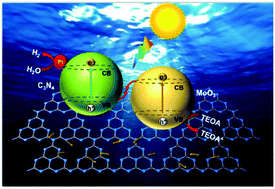Highly enhanced H2 evolution of MoO3/g-C3N4 hybrid composites based on a direct Z-scheme photocatalytic system†
Abstract
The Z-scheme photocatalytic system has great potential in solar energy conservation with simultaneous wide light-absorption range, efficient electron–hole pair separation and strong redox ability. Herein, a direct Z-scheme g-C3N4/MoO3 photocatalytic composite with oxygen vacancies is successfully fabricated via a facile in situ method of a one-pot pyrolysis strategy. The as-prepared g-C3N4/MoO3 possesses a porous architecture with increased specific surface area. The existence of an oxygen vacancy in MoO3 is verified by XPS, UV-DRS analysis and electrochemical measurements. The g-C3N4/MoO3 exhibits superior visible-light photocatalytic performance for water splitting, as evidenced by an about 17-fold (20.52 μmol h−1) increase in the rate of H2 evolution relative to pristine C3N4 (1.23 μmol h−1). According to the characterization results and boosted photocatalytic performance, the migration and separation of photoinduced charge carriers in g-C3N4/MoO3 follows a possible mechanism based on a Z-scheme photocatalytic system constructed by the oxygen vacancies. The O-vacancy functions as the recombination and storage center for fast charge transfer through two components. The combined effect of defective MoO3 and a Z-scheme interfacial heterojunction has achieved greatly enhanced photocatalytic performance. This work demonstrates the facilitation effect of an effective Z-scheme system involving oxygen vacancies on the charge transfer to enhance the photocatalytic activity for water splitting.

- This article is part of the themed collection: 2020 Inorganic Chemistry Frontiers HOT articles


 Please wait while we load your content...
Please wait while we load your content...